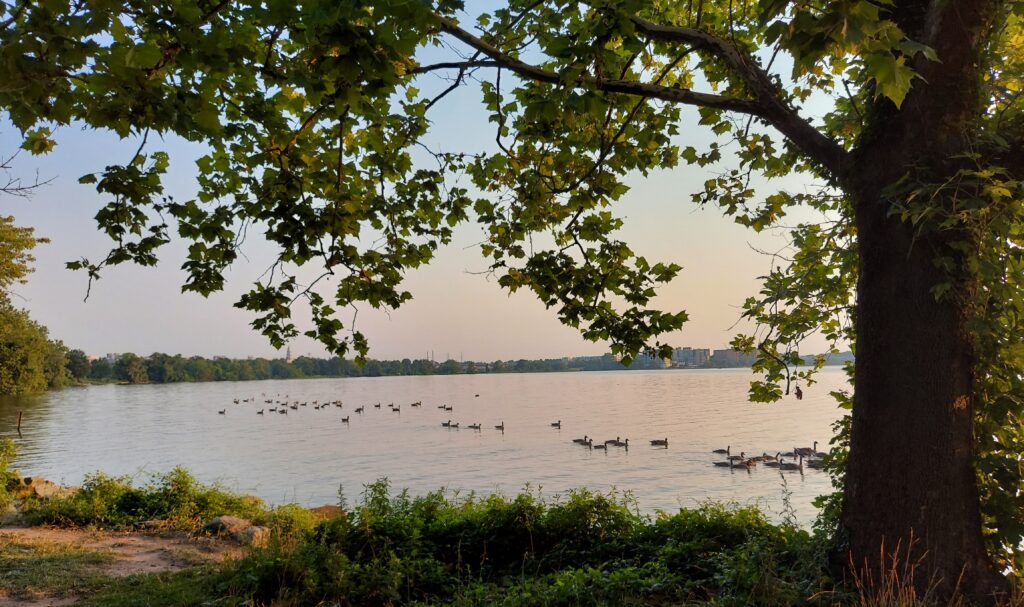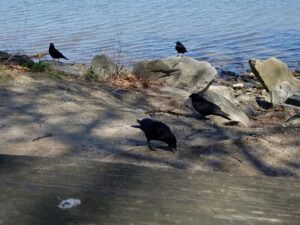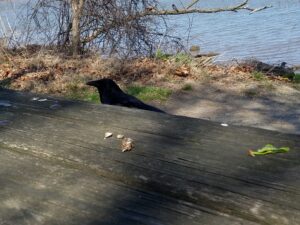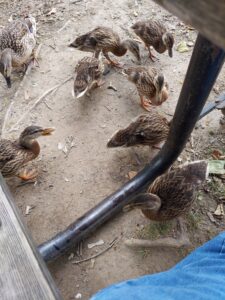FEEDING WILD ANIMALS, PART 1. MAKING FRIENDS OF FEATHERED AND FURRED

It started with crows. I am partial to crows, intelligent birds that shape tools out of raw materials such as twigs and wire. A biologist who was studying crows told me during an interview that he fed peanuts to those in his neighborhood, and they learned to recognize him . . . and his car. When he drove down his street, crows sometimes followed him, no doubt to cadge a few peanuts. After hearing that story, I wanted a flock of crows following my Prius around the neighborhood.

The crows that visit my backyard are alarmists. They’ve seen me dozens of times putting out fruit and bread for them, but when from my window I see them infiltrating my yard— moving silently among tall trees, shadows inside of shadows—and I go outside: instant alarm call, and all but one flee. I put out crow grub—the same foods I eat. The solitary bird gives out a call when I go inside. The others return and hit the buffet.
Befriending Crows
Recently I started working on a new book at my al fresco office—a park situated along a wide, tidal river. Picnic tables stand so close to the bank that you can throw a peanut from a table into the water with little effort or hand-to-eye coordination. Some of the shade trees appear to be more than 100 years old, judging from their girth. And among the trees: crows.
No signs at this park warn against feeding wildlife. Needless to say, a few crows in a tree above my picnic table late last spring were a temptation. Visions of crows coming to greet me each time I arrived at the park flew through my fantasies. I happened to have a little packet of almonds and walnuts in my canvas satchel. I threw some on the ground. And some bread from a sandwich I had brought with me. They came down and took the food. To my surprise, they were very orderly about it. One crow would take some food, while others stood in line nearby. When the first finished, another moved in and took some food, and when it left, in came another.
One crow landed on the bench on the opposite side of my picnic table, katy-corner to me, and sat there looking at me as if we were dining together. The perfect opportunity to toss it something to eat on top of the table. But I was out of food. I didn’t want that to happen again, so the next time I was at the park, I brought along 8 pounds of peanuts in the shell.

Web-footed Rivals
Sad to say, none of my feathered friends showed up, so there I was, alone with a massive amount of peanuts. But on my next visit, a crow glided into a tree above my table. At the same time, a dozen or so mallard ducks swam up, including half a dozen half-grown ducklings that I’d probably first spotted a few weeks earlier, when they were brown-tinged, yellow balls of buoyant fluff, floating in their mother’s wake on the river.
Ducks and geese are among the most-fed animals in this park. If you stand on the river bank and make throwing motions toward the water, they will instantly paddle in your direction. I found that I could get them to walk up to my picnic table if I threw peanuts among the rocks on shore and then farther up the bank until they were well within the area around my table. Other ducks would see the first group and rapidly join in.
Avian Epicures
I quickly learned that while crows will deftly open a peanut in a shell, not so ducks. They would pick up a peanut in a shell, mouth it chomp chomp chomp and immediately drop it. I had to shell the peanuts to get the ducks to eat them. Bouncing nervously around, sometimes snapping at one another with their bills, tugging at feather tufts, they would watch me crack open the peanuts, then rush in when I threw them at their feet. Some of the ducks were highly aggressive, attacking other ducks Some stood patiently to the side. I would throw peanuts directly to the patient ones. The whole flock would shift around when I did so, pursuing peanuts. The ducklings would come all the way to the table and even under it to get peanuts, but the adults kept a certain distance, generally avoiding me by six or seven feet.  When I ran out of nuts or stopped feeding, the ducklings went under the table and settled down for a nap, right beside my feet.
When I ran out of nuts or stopped feeding, the ducklings went under the table and settled down for a nap, right beside my feet.
Please read more about the ducklings and other park denizens in next week’s installment of this blog.